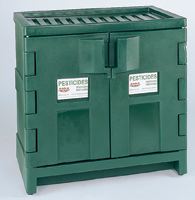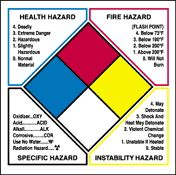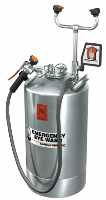 |
 |
| MSDS Topics |
Free Sites | FAQ's | Regulations | Glossary | Software | Suppliers |
| Books | Forum | Poll | Fun stuff | Quiz | Store | |
| MSDS and safety supplies | Search ALL our MSDS info | |||||
 | |||
 |
 |
 |
|
| Title: 05/01/1986 - Applicability of the Hazard Communication standard to pesticides. | |
| Record Type: Interpretation | Standard Number: 1910.1200(f)(4)(i); 1910.1200(f)(4)(ii) |
|
May 1, 1986
Mr. S. M. Duskin Dear Mr. Duskin: This is in response to your letters of October 3, 1985, and April 10 regarding the Hazard Communication Standard (HCS). Please excuse our delay in responding and any inconvenience it may have caused. The following are our responses to your specific questions, which we have repeated for ease of reference: |  Get pesticide and flammable storage cabinets at Safety Emporium. |
ANSWER: The methods described in your question appear to fit into the category of labeling alternatives found under paragraph (f)(5) of 29 CFR 1910.1200. As such they will meet the intent of the standard as long as the use of this method is restricted to stationary process containers.
ANSWER: For in-plant labels the standard identifies two requirements: chemical identity and appropriate hazard warnings (29 CFR 1910.1200 (f)(4)(i) and (f)(4)(ii)). The "SULFURIC ACID" wording would satisfy the identity requirements as long as the same term was utilized for cross-referencing purposes on the material safety data sheets and required list of hazardous chemicals. The requirement for "appropriate hazard warning" will only be met in all significant health and physical effects appear on the label. The labeling alternative referenced in our response to your first question should be consulted for further guidance.
ANSWER: From your question it would appear that the facility concerned is not currently one of the industries covered by the scope of the standard (Standard Industrial Classification (SIC) Codes 20-39) [ILPI Says: Caution: see this note below]. It is recommended that material safety data sheets be made available because of the predictable exposure you have referenced.
ANSWER: If the location has been classified in SIC codes 20 through 39 then it would be within the scope of the HCS [ILPI Says: Caution: see this note below]. The employer would be required to maintain copies of the material safety data sheets for each hazardous chemical in the workplace as well as providing training and meeting all of the requirements of the HCS that apply to a chemical manufacturer. Establishments blending and formulating fertilizers and pesticides are normally classified in SIC Codes 2875 or 2879 [ILPI Says: Caution: see this note below]. Employers involved in the application of pesticides fall under standards established by the U.S. Environmental Protection Agency (EPA).
ANSWER: If the manufacturer is selling to the distributor and not the outlets, then the manufacturer is only required to provide material safety data sheets to the distributor. It is the distributor's responsibility to furnish material safety data sheets to other distributors and employers in SIC codes 20-39 [ILPI Says: Caution: see this note below].
ANSWER: The term pesticide warehouse at first glance appears to present an establishment that does not fall within the scope of SIC codes covered by the HCS [ILPI Says: Caution: see this note below]. Your question however, indicates that some blending and repackaging is customary. These operations are included in those that are used to define a chemical manufacturer with respect to the HCS applicability; reference the definitions for "chemical manufacturer" and "produce" under paragraph (c) of 29 CFR 1910.1200. As a chemical manufacturer the establishment would have to meet the standard in-house requirements for a written program, labeling, material safety data sheets and training.
ANSWER: No, These locations would not be included in the scope of the standard.
Note: This question is a variant of Question 6.
ANSWER: Please refer back to our answer to question number 6 As a manufacturer of pesticides you are still required to comply with the HCS requirements, except those specific labeling exemptions referenced under 29 CFR 1910.1200 (b).
ANSWER: If the establishment is classified in SIC codes 20 through 39 then all applicable provisions of the HCS would apply [ILPI Says: Caution: see this note below]. The chemical manufacturing, importer or distributor should supply the material safety data sheet for the hazardous chemicals purchased from these sources. The formulating facility would provide material safety data sheets to distributors and other chemical manufacturers.
ANSWER: The SIC code of the formulator is the determining factor [ILPI Says: Caution: see this note below]. The distributor would be required to provide material safety data sheets to formulators classified in SIC codes 20 through 39 [ILPI Says: Caution: see this note below].
|
The answers above that relate to the standard's application by SIC code must be modified in States where a more expansive standard has been enacted. ILPI Says: the SIC code requirements were changed. The entire manufacturing and construction industry is covered by the current standard. We hope that we have adequately addressed your inquiry and you are able to apply our responses to the summary paragraph of your questions. Again, we apologize for the delay in this response and any inconvenience you may have experienced. If we can be of further assistance, please do not hesitate to contact us. Sincerely, John B. Miles, Jr., Director |  Communicate workplace hazards with handy labels from Safety Emporium. |
April 10, 1986
Mr. Patrick Tyson
Acting Assistant Secretary
Occupational Safety ∓ Health
U. S. Department of Labor
200 Constitution Ave., NW
Washington, DC 20210
Dear Mr. Tyson:
|
On October 3, 1986 after conversation with Jennifer Silk we wrote to Mr. John B. Miles requesting written interpretations to clarify certain ambiguities - at least to us - in OSHA's Hazardous Communication regulations. To date we have not received even an acknowledgment, much less a reply. The Southern Agricultural Chemicals association (SACA) is an independent, regional trade association composed of formulators, distributors, basic manufacturers of agricultural pesticides, & suppliers of products and services to the industry. The Association's membership represents over 90 percent of those companies in the aforementioned categories which operate in thirteen southern states extending from Delaware-Maryland across the South to include Louisiana & Arkansas across the Mississippi. SACA supports strongly the intent of the rules and only wishes to assist its members in complying with them. With assistance from OSHA in clarifying the rules to the maximum extent possible we can help to make our workplaces more safe for workers and others. Please assist us in assuring appropriate actions to produce a response to the questions posed in our letter. |
 Working at a remote location? Portable eye wash units from Safety Emporium can help meet OSHA requirements. |
E. W. Duskin
Executive Vice President
October 4, 1985
Mr. John Miles
Director of Field Operations
U. S. Department of Labor
Occupational Safety & Health
Administration/Rm.N-3603
200 Constitution Avenue
Washington, DC 20210
Dear Mr. Miles:
|
I am writing to pose several questions to your compliance with OSHA's Hazard Communication Standard. Jennifer Silk suggested your office would be best qualified to answer our questions. Most pertain to the requirement to provide MSDS's to certain users who deal with agricultural pesticides and fertilizers. Our people have attended various workshops and have access to your Instruction CPL 2-2.38 and MSDS Contents Summary. The attached questions/situations pertain to some of our members & are not clearly covered in the rules clarifications issued thus far. We would very much appreciate your office looking into the situations posed and giving us written guidance & interpretation so that we may publish it to our members, thus better assuring compliance with the rules. |  Ensure OSHA compliance with training materials and supplies from Safety Emporium. |
Yours Very Truly,
E. W. Duskin
Executive Vice President
enclosure: Questions/Situations
Following are some specific questions that were suggested by the SACA/OSHA Worker Safety Committee:
QUESTIONS: Does this system satisfy labeling requirements of the OSHA Communication Standards?
QUESTION: Does this composite label meet the OSHA requirements?
QUESTION: Are MSDSs required to be on site for all of the products? What type of training, if any, is required under the OSHA standards?
QUESTION: Are MSDSs required to be on site for all the products? What type of training, if any, is required for the company personnel under OSHA standards?
QUESTION: To whom should MSDSs be available or disseminated and what type of training is required?
QUESTION: Are MSDSs, training, and a written program required for any of these locations?
NOTE: This question is a variant of Question (6).
QUESTION: Is such a facility considered to be a "manufacturing facility"? If yes, which of the following would it be required to comply with: training, plan, MSDS on file, MSDS delivery to the purchaser? Would the FIPRA exemption apply? If not, why not?
QUESTION: Would it be required to meet the full range of hazard communications standards? To whom would it provide MSDSs? From whom should it obtain them?
QUESTION: Does this sale of an "end-use" vs a "manufacturing-use" product to a formulator subject the distributor to OSHA Hazard Communication Rules? To all? If not, to which requirements?
The official, public domain, OSHA version of this document is available at http://www.osha.gov/pls/oshaweb/owadisp.show_document?p_table=INTERPRETATIONS&p_id=19427&p_text_version=FALSE